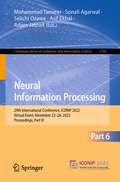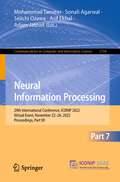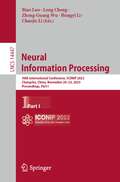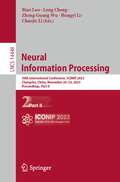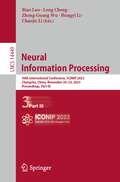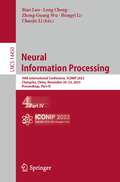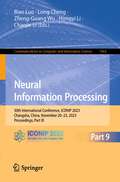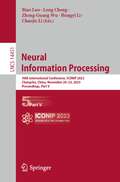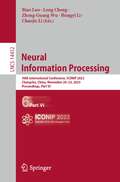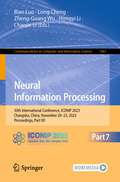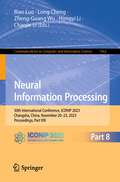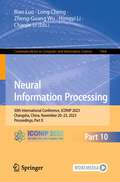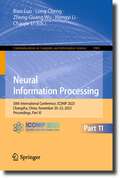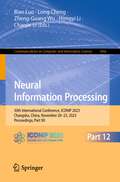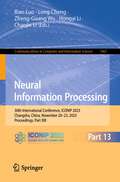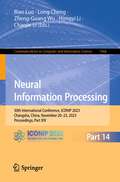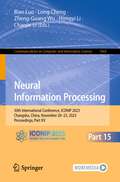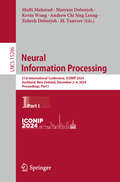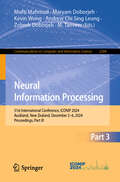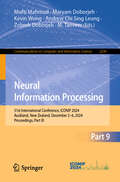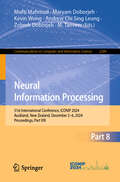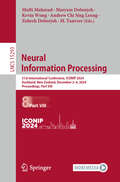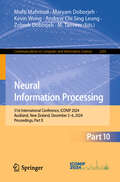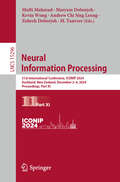- Table View
- List View
Neural Information Processing: 29th International Conference, ICONIP 2022, Virtual Event, November 22–26, 2022, Proceedings, Part VI (Communications in Computer and Information Science #1793)
by Seiichi Ozawa Adam Jatowt Sonali Agarwal Mohammad Tanveer Asif EkbalThe four-volume set CCIS 1791, 1792, 1793 and 1794 constitutes the refereed proceedings of the 29th International Conference on Neural Information Processing, ICONIP 2022, held as a virtual event, November 22–26, 2022. The 213 papers presented in the proceedings set were carefully reviewed and selected from 810 submissions. They were organized in topical sections as follows: Theory and Algorithms; Cognitive Neurosciences; Human Centered Computing; and Applications.The ICONIP conference aims to provide a leading international forum for researchers, scientists, and industry professionals who are working in neuroscience, neural networks, deep learning, and related fields to share their new ideas, progress, and achievements.
Neural Information Processing: 29th International Conference, ICONIP 2022, Virtual Event, November 22–26, 2022, Proceedings, Part VII (Communications in Computer and Information Science #1794)
by Seiichi Ozawa Adam Jatowt Sonali Agarwal Mohammad Tanveer Asif EkbalThe four-volume set CCIS 1791, 1792, 1793 and 1794 constitutes the refereed proceedings of the 29th International Conference on Neural Information Processing, ICONIP 2022, held as a virtual event, November 22–26, 2022. The 213 papers presented in the proceedings set were carefully reviewed and selected from 810 submissions. They were organized in topical sections as follows: Theory and Algorithms; Cognitive Neurosciences; Human Centered Computing; and Applications.The ICONIP conference aims to provide a leading international forum for researchers, scientists, and industry professionals who are working in neuroscience, neural networks, deep learning, and related fields to share their new ideas, progress, and achievements.
Neural Information Processing: 30th International Conference, ICONIP 2023, Changsha, China, November 20–23, 2023, Proceedings, Part I (Lecture Notes in Computer Science #14447)
by Hongyi Li Long Cheng Zheng-Guang Wu Biao Luo Chaojie LiThe six-volume set LNCS 14447 until 14452 constitutes the refereed proceedings of the 30th International Conference on Neural Information Processing, ICONIP 2023, held in Changsha, China, in November 2023. The 652 papers presented in the proceedings set were carefully reviewed and selected from 1274 submissions. They focus on theory and algorithms, cognitive neurosciences; human centred computing; applications in neuroscience, neural networks, deep learning, and related fields.
Neural Information Processing: 30th International Conference, ICONIP 2023, Changsha, China, November 20–23, 2023, Proceedings, Part II (Lecture Notes in Computer Science #14448)
by Hongyi Li Long Cheng Zheng-Guang Wu Biao Luo Chaojie LiThe six-volume set LNCS 14447 until 14452 constitutes the refereed proceedings of the 30th International Conference on Neural Information Processing, ICONIP 2023, held in Changsha, China, in November 2023. The 652 papers presented in the proceedings set were carefully reviewed and selected from 1274 submissions. They focus on theory and algorithms, cognitive neurosciences; human centred computing; applications in neuroscience, neural networks, deep learning, and related fields.
Neural Information Processing: 30th International Conference, ICONIP 2023, Changsha, China, November 20–23, 2023, Proceedings, Part III (Lecture Notes in Computer Science #14449)
by Hongyi Li Long Cheng Zheng-Guang Wu Biao Luo Chaojie LiThe six-volume set LNCS 14447 until 14452 constitutes the refereed proceedings of the 30th International Conference on Neural Information Processing, ICONIP 2023, held in Changsha, China, in November 2023. The 652 papers presented in the proceedings set were carefully reviewed and selected from 1274 submissions. They focus on theory and algorithms, cognitive neurosciences; human centred computing; applications in neuroscience, neural networks, deep learning, and related fields.
Neural Information Processing: 30th International Conference, ICONIP 2023, Changsha, China, November 20–23, 2023, Proceedings, Part IV (Lecture Notes in Computer Science #14450)
by Hongyi Li Long Cheng Zheng-Guang Wu Biao Luo Chaojie LiThe six-volume set LNCS 14447 until 14452 constitutes the refereed proceedings of the 30th International Conference on Neural Information Processing, ICONIP 2023, held in Changsha, China, in November 2023. The 652 papers presented in the proceedings set were carefully reviewed and selected from 1274 submissions. They focus on theory and algorithms, cognitive neurosciences; human centred computing; applications in neuroscience, neural networks, deep learning, and related fields.
Neural Information Processing: 30th International Conference, ICONIP 2023, Changsha, China, November 20–23, 2023, Proceedings, Part IX (Communications in Computer and Information Science #1963)
by Hongyi Li Long Cheng Zheng-Guang Wu Biao Luo Chaojie LiThe nine-volume set constitutes the refereed proceedings of the 30th International Conference on Neural Information Processing, ICONIP 2023, held in Changsha, China, in November 2023. The 1274 papers presented in the proceedings set were carefully reviewed and selected from 652 submissions. The ICONIP conference aims to provide a leading international forum for researchers, scientists, and industry professionals who are working in neuroscience, neural networks, deep learning, and related fields to share their new ideas, progress, and achievements.
Neural Information Processing: 30th International Conference, ICONIP 2023, Changsha, China, November 20–23, 2023, Proceedings, Part V (Lecture Notes in Computer Science #14451)
by Hongyi Li Long Cheng Zheng-Guang Wu Biao Luo Chaojie LiThe six-volume set LNCS 14447 until 14452 constitutes the refereed proceedings of the 30th International Conference on Neural Information Processing, ICONIP 2023, held in Changsha, China, in November 2023. The 652 papers presented in the proceedings set were carefully reviewed and selected from 1274 submissions. They focus on theory and algorithms, cognitive neurosciences; human centred computing; applications in neuroscience, neural networks, deep learning, and related fields.
Neural Information Processing: 30th International Conference, ICONIP 2023, Changsha, China, November 20–23, 2023, Proceedings, Part VI (Lecture Notes in Computer Science #14452)
by Hongyi Li Long Cheng Zheng-Guang Wu Biao Luo Chaojie LiThe six-volume set LNCS 14447 until 14452 constitutes the refereed proceedings of the 30th International Conference on Neural Information Processing, ICONIP 2023, held in Changsha, China, in November 2023. The 652 papers presented in the proceedings set were carefully reviewed and selected from 1274 submissions. They focus on theory and algorithms, cognitive neurosciences; human centred computing; applications in neuroscience, neural networks, deep learning, and related fields.
Neural Information Processing: 30th International Conference, ICONIP 2023, Changsha, China, November 20–23, 2023, Proceedings, Part VII (Communications in Computer and Information Science #1961)
by Hongyi Li Long Cheng Zheng-Guang Wu Biao Luo Chaojie LiThe nine-volume set constitutes the refereed proceedings of the 30th International Conference on Neural Information Processing, ICONIP 2023, held in Changsha, China, in November 2023. The 1274 papers presented in the proceedings set were carefully reviewed and selected from 652 submissions. The ICONIP conference aims to provide a leading international forum for researchers, scientists, and industry professionals who are working in neuroscience, neural networks, deep learning, and related fields to share their new ideas, progress, and achievements.
Neural Information Processing: 30th International Conference, ICONIP 2023, Changsha, China, November 20–23, 2023, Proceedings, Part VIII (Communications in Computer and Information Science #1962)
by Hongyi Li Long Cheng Zheng-Guang Wu Biao Luo Chaojie LiThe nine-volume set constitutes the refereed proceedings of the 30th International Conference on Neural Information Processing, ICONIP 2023, held in Changsha, China, in November 2023. The 1274 papers presented in the proceedings set were carefully reviewed and selected from 652 submissions. The ICONIP conference aims to provide a leading international forum for researchers, scientists, and industry professionals who are working in neuroscience, neural networks, deep learning, and related fields to share their new ideas, progress, and achievements.
Neural Information Processing: 30th International Conference, ICONIP 2023, Changsha, China, November 20–23, 2023, Proceedings, Part X (Communications in Computer and Information Science #1964)
by Hongyi Li Long Cheng Zheng-Guang Wu Biao Luo Chaojie LiThe nine-volume set constitutes the refereed proceedings of the 30th International Conference on Neural Information Processing, ICONIP 2023, held in Changsha, China, in November 2023. The 1274 papers presented in the proceedings set were carefully reviewed and selected from 652 submissions. The ICONIP conference aims to provide a leading international forum for researchers, scientists, and industry professionals who are working in neuroscience, neural networks, deep learning, and related fields to share their new ideas, progress, and achievements.
Neural Information Processing: 30th International Conference, ICONIP 2023, Changsha, China, November 20–23, 2023, Proceedings, Part XI (Communications in Computer and Information Science #1965)
by Hongyi Li Long Cheng Zheng-Guang Wu Biao Luo Chaojie LiThe nine-volume set constitutes the refereed proceedings of the 30th International Conference on Neural Information Processing, ICONIP 2023, held in Changsha, China, in November 2023. The 1274 papers presented in the proceedings set were carefully reviewed and selected from 652 submissions. The ICONIP conference aims to provide a leading international forum for researchers, scientists, and industry professionals who are working in neuroscience, neural networks, deep learning, and related fields to share their new ideas, progress, and achievements.
Neural Information Processing: 30th International Conference, ICONIP 2023, Changsha, China, November 20–23, 2023, Proceedings, Part XII (Communications in Computer and Information Science #1966)
by Hongyi Li Long Cheng Zheng-Guang Wu Biao Luo Chaojie LiThe nine-volume set constitutes the refereed proceedings of the 30th International Conference on Neural Information Processing, ICONIP 2023, held in Changsha, China, in November 2023. The 1274 papers presented in the proceedings set were carefully reviewed and selected from 652 submissions. The ICONIP conference aims to provide a leading international forum for researchers, scientists, and industry professionals who are working in neuroscience, neural networks, deep learning, and related fields to share their new ideas, progress, and achievements.
Neural Information Processing: 30th International Conference, ICONIP 2023, Changsha, China, November 20–23, 2023, Proceedings, Part XIII (Communications in Computer and Information Science #1967)
by Hongyi Li Long Cheng Zheng-Guang Wu Biao Luo Chaojie LiThe nine-volume set constitutes the refereed proceedings of the 30th International Conference on Neural Information Processing, ICONIP 2023, held in Changsha, China, in November 2023. The 1274 papers presented in the proceedings set were carefully reviewed and selected from 652 submissions. The ICONIP conference aims to provide a leading international forum for researchers, scientists, and industry professionals who are working in neuroscience, neural networks, deep learning, and related fields to share their new ideas, progress, and achievements.
Neural Information Processing: 30th International Conference, ICONIP 2023, Changsha, China, November 20–23, 2023, Proceedings, Part XIV (Communications in Computer and Information Science #1968)
by Hongyi Li Long Cheng Zheng-Guang Wu Biao Luo Chaojie LiThe nine-volume set constitutes the refereed proceedings of the 30th International Conference on Neural Information Processing, ICONIP 2023, held in Changsha, China, in November 2023. The 1274 papers presented in the proceedings set were carefully reviewed and selected from 652 submissions. The ICONIP conference aims to provide a leading international forum for researchers, scientists, and industry professionals who are working in neuroscience, neural networks, deep learning, and related fields to share their new ideas, progress, and achievements.
Neural Information Processing: 30th International Conference, ICONIP 2023, Changsha, China, November 20–23, 2023, Proceedings, Part XV (Communications in Computer and Information Science #1969)
by Hongyi Li Long Cheng Zheng-Guang Wu Biao Luo Chaojie LiThe nine-volume set constitutes the refereed proceedings of the 30th International Conference on Neural Information Processing, ICONIP 2023, held in Changsha, China, in November 2023. The 1274 papers presented in the proceedings set were carefully reviewed and selected from 652 submissions. The ICONIP conference aims to provide a leading international forum for researchers, scientists, and industry professionals who are working in neuroscience, neural networks, deep learning, and related fields to share their new ideas, progress, and achievements.
Neural Information Processing: 31st International Conference, ICONIP 2024, Auckland, New Zealand, December 2–6, 2024, Proceedings, Part I (Lecture Notes in Computer Science #15286)
by Kevin Wong M. Tanveer Mufti Mahmud Maryam Doborjeh Andrew Chi Sing Leung Zohreh DoborjehThe eleven-volume set LNCS 15286-15296 constitutes the refereed proceedings of the 31st International Conference on Neural Information Processing, ICONIP 2024, held in Auckland, New Zealand, in December 2024.The 318 regular papers presented in the proceedings set were carefully reviewed and selected from 1301 submissions. They focus on four main areas, namely: theory and algorithms; cognitive neurosciences; human-centered computing; and applications.
Neural Information Processing: 31st International Conference, ICONIP 2024, Auckland, New Zealand, December 2–6, 2024, Proceedings, Part III (Communications in Computer and Information Science #2284)
by Kevin Wong M. Tanveer Mufti Mahmud Maryam Doborjeh Andrew Chi Sing Leung Zohreh DoborjehThe sixteen-volume set, CCIS 2282-2297, constitutes the refereed proceedings of the 31st International Conference on Neural Information Processing, ICONIP 2024, held in Auckland, New Zealand, in December 2024. The 472 regular papers presented in this proceedings set were carefully reviewed and selected from 1301 submissions. These papers primarily focus on the following areas: Theory and algorithms; Cognitive neurosciences; Human-centered computing; and Applications.
Neural Information Processing: 31st International Conference, ICONIP 2024, Auckland, New Zealand, December 2–6, 2024, Proceedings, Part IX (Communications in Computer and Information Science #2290)
by Kevin Wong M. Tanveer Mufti Mahmud Maryam Doborjeh Andrew Chi Sing Leung Zohreh DoborjehThe sixteen-volume set, CCIS 2282-2297, constitutes the refereed proceedings of the 31st International Conference on Neural Information Processing, ICONIP 2024, held in Auckland, New Zealand, in December 2024. The 472 regular papers presented in this proceedings set were carefully reviewed and selected from 1301 submissions. These papers primarily focus on the following areas: Theory and algorithms; Cognitive neurosciences; Human-centered computing; and Applications.
Neural Information Processing: 31st International Conference, ICONIP 2024, Auckland, New Zealand, December 2–6, 2024, Proceedings, Part VIII (Communications in Computer and Information Science #2289)
by Kevin Wong M. Tanveer Mufti Mahmud Maryam Doborjeh Andrew Chi Sing Leung Zohreh DoborjehThe sixteen-volume set, CCIS 2282-2297, constitutes the refereed proceedings of the 31st International Conference on Neural Information Processing, ICONIP 2024, held in Auckland, New Zealand, in December 2024. The 472 regular papers presented in this proceedings set were carefully reviewed and selected from 1301 submissions. These papers primarily focus on the following areas: Theory and algorithms; Cognitive neurosciences; Human-centered computing; and Applications.
Neural Information Processing: 31st International Conference, ICONIP 2024, Auckland, New Zealand, December 2–6, 2024, Proceedings, Part VIII (Lecture Notes in Computer Science #15293)
by Kevin Wong M. Tanveer Mufti Mahmud Maryam Doborjeh Andrew Chi Sing Leung Zohreh DoborjehThe eleven-volume set LNCS 15286-15296 constitutes the refereed proceedings of the 31st International Conference on Neural Information Processing, ICONIP 2024, held in Auckland, New Zealand, in December 2024.The 318 regular papers presented in the proceedings set were carefully reviewed and selected from 1301 submissions. They focus on four main areas, namely: theory and algorithms; cognitive neurosciences; human-centered computing; and applications.
Neural Information Processing: 31st International Conference, ICONIP 2024, Auckland, New Zealand, December 2–6, 2024, Proceedings, Part X (Communications in Computer and Information Science #2291)
by Kevin Wong M. Tanveer Mufti Mahmud Maryam Doborjeh Andrew Chi Sing Leung Zohreh DoborjehThe sixteen-volume set, CCIS 2282-2297, constitutes the refereed proceedings of the 31st International Conference on Neural Information Processing, ICONIP 2024, held in Auckland, New Zealand, in December 2024. The 472 regular papers presented in this proceedings set were carefully reviewed and selected from 1301 submissions. These papers primarily focus on the following areas: Theory and algorithms; Cognitive neurosciences; Human-centered computing; and Applications.
Neural Information Processing: 31st International Conference, ICONIP 2024, Auckland, New Zealand, December 2–6, 2024, Proceedings, Part XI (Lecture Notes in Computer Science #15296)
by Kevin Wong M. Tanveer Mufti Mahmud Maryam Doborjeh Andrew Chi Sing Leung Zohreh DoborjehThe eleven-volume set LNCS 15286-15295 constitutes the refereed proceedings of the 31st International Conference on Neural Information Processing, ICONIP 2024, held in Auckland, New Zealand, in December 2024. The 318 regular papers presented in the proceedings set were carefully reviewed and selected from 1301 submissions. They focus on four main areas, namely: theory and algorithms; cognitive neurosciences; human-centered computing; and applications.
Neural Machine Translation
by Philipp KoehnDeep learning is revolutionizing how machine translation systems are built today. This book introduces the challenge of machine translation and evaluation - including historical, linguistic, and applied context -- then develops the core deep learning methods used for natural language applications. Code examples in Python give readers a hands-on blueprint for understanding and implementing their own machine translation systems. <p><p>The book also provides extensive coverage of machine learning tricks, issues involved in handling various forms of data, model enhancements, and current challenges and methods for analysis and visualization. <p><p>Summaries of the current research in the field make this a state-of-the-art textbook for undergraduate and graduate classes, as well as an essential reference for researchers and developers interested in other applications of neural methods in the broader field of human language processing.
